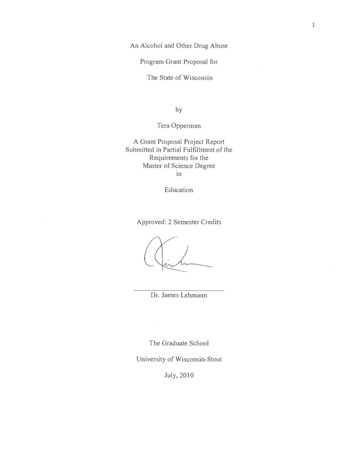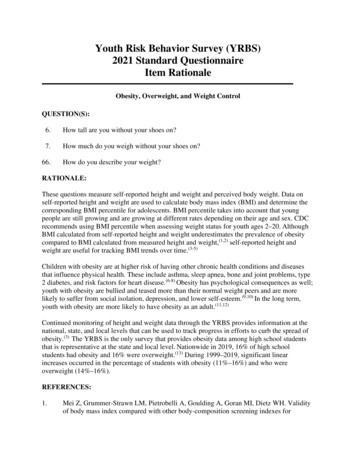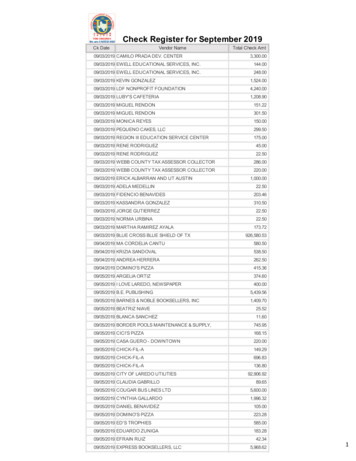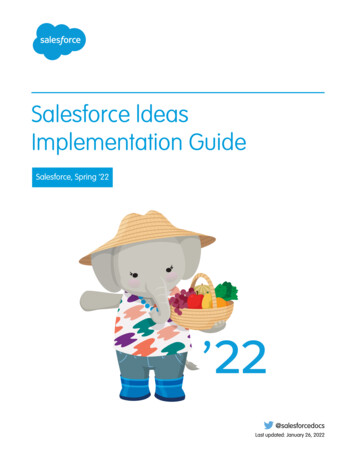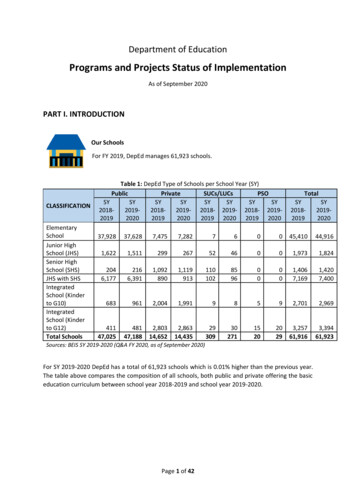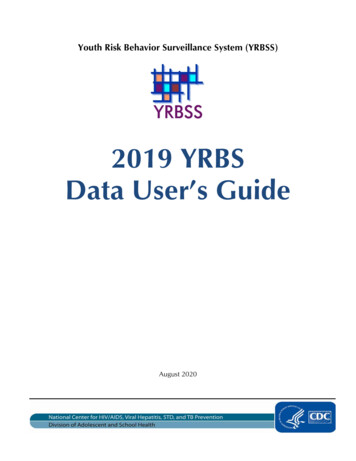
Transcription
Youth Risk Behavior Surveillance System (YRBSS)2019 YRBSData User’s GuideAugust 2020
2 0 1 9Y O U T HR I S KB E H A V I O RS U R V E Y2019 YRBS Data User’s GuideTable of ContentsIntroduction to the YRBSS . 1Introduction. 1Uses of YRBSS Results . 1Components of the YRBSS . 1Methods. 2For More Information . 2Sample Description. 3School Level Selection . 3Class Level Selection. 3Response Rates . 3Data Edits. 4Introduction. 4Single Question Edits. 4Height and Weight Edits. 4Body Mass Index (BMI) Edits. 5Biologically Implausible Value Edits . 5Logical Consistency Edits. 6Edit Criteria. 6Subverting Records. 10Calculated Variables . 11Introduction. 11Race/Ethnicity. 11Percentile, Overweight, and Obese. 12Dichotomous Variables. 13QN# Variables: . 13QNword Variables . 13Data Analysis Variables. 14Weight. 14Stratum. 14PSU . 14For More Information . 14Analysis Software Technical Notes . 15Introduction. 15
2 0 1 9Y O U T HR I S KB E H A V I O RS U R V E YSoftware Requirements. 15Sexual Minority Data Analysis Notes. 16Introduction. 16Background . 16Codebook . 17Introduction. 17Data Location. 17Variable Name . 17Question Code and Label. 17Unweighted Frequency . 17Weighted Percentage . 17Appendix A: National High School YRBS Questions and Dichotomous Variables. 18Appendix B: National YRBS Supplemental (QNword) Variables. 52Appendix C: National High School YRBS Codebook . 54
2 0 1 9Y O U T HR I S KB E H A V I O RS U R V E YIntroduction to the YRBSSIntroductionThe YRBSS was developed in 1990 to monitor priority health risk behaviorsthat contribute markedly to the leading causes of death, disability, and socialproblems among youth and adults in the United States. These behaviors, oftenestablished during childhood and early adolescence, include Behaviors that contribute to unintentional injuries and violence.Sexual behaviors that contribute to unintended pregnancy and sexuallytransmitted infections, including HIV infection.Alcohol and other drug use.Tobacco use.Unhealthy dietary behaviors.Inadequate physical activity.In addition, the YRBSS monitors the prevalence of obesity and asthma.From 1991 through 2019, the YRBSS has collected data from more than 4.9million high school students in more than 2,100 separate surveys.Uses of YRBSSResultsThe YRBSS was designed to Components ofthe YRBSSDetermine the prevalence of health risk behaviors.Assess whether health risk behaviors increase, decrease, or stay thesame over time.Examine the co-occurrence of health risk behaviors.Provide comparable national, state, territorial, tribal, and local data.Provide comparable data among subpopulations of youth.Monitor progress toward achieving the Healthy People objectives andother program indicators.The YRBSS includes national, state, territorial, tribal government, and localschool-based surveys of representative samples of 9th through 12th gradestudents. These surveys are conducted every two years, usually during thespring semester. The national survey, conducted by CDC, provides datarepresentative of 9th through 12th grade students in public and privateschools in the United States. The state, territorial, tribal government, and localsurveys, conducted by departments of health and education, provide datarepresentative of mostly public high school students in each jurisdiction.The YRBSS also includes additional surveys conducted by CDC:August 2020http://www.cdc.gov/yrbssPage 1
2 0 1 9Y O U T H R I S KB E H A V I O RS U R V E YA middle school survey conducted by interested states, territories,tribal governments, and large urban school districts.A 2010 study to measure physical activity and nutrition-relatedbehaviors and determinants of these behaviors among a nationallyrepresentative sample of high school students.A series of methods studies conducted in 1992, 2000, 2002, 2004, and2008 to improve the quality and interpretation of the YRBSS data.The National Alternative High School Youth Risk Behavior Surveyconducted in 1998 among a representative sample of almost 9,000students in alternative high schools.The National College Health Risk Behavior Survey conducted in 1995among a representative sample of about 5,000 undergraduate students.MethodsThe National Youth Risk Behavior Survey (YRBS) uses a three-stage clustersample design to produce a representative sample of 9th through 12th gradestudents. The target population consisted of all public, Catholic, and otherprivate school students in grades 9 through 12. A weighting factor wasapplied to each student record to adjust for nonresponse and the oversamplingof black and Hispanic students in the sample. The final, overall weights werescaled so the weighted count of students was equal to the total sample size,and the weighted proportions of students in each grade matched populationprojections for each survey year. Because of the complexity of the clustersampling design used, a statistical software package that can calculatesampling variance appropriately must be used. This document provides theinformation needed to correctly use and analyze data from the 2019 NationalYRBS.For MoreInformationVisit the YRBSS web site at www.cdc.gov/yrbss for more information on theYRBSS, its methodology, data analysis, and answers to frequently askedquestions.August 2020http://www.cdc.gov/yrbssPage 2
2 0 1 9Y O U T HR I S KB E H A V I O RS U R V E YSample DescriptionSchool LevelSelectionAll regular public, Catholic, and other private school students, in grades 9through 12, in the 50 States and the District of Columbia were included in thesampling frame for the 2019 national YRBS. Puerto Rico, the trust territories,and the Virgin Islands were excluded from the frame. Schools were selectedsystematically with probability proportional to enrollment in grades 9 through12 using a random start. One hundred and eighty-one schools were sampled.Class LevelSelectionAll classes in a required subject or all classes meeting during a particularperiod of the day, depending on the school, were included in the samplingframe. Systematic equal probability sampling with a random start was used toselect classes from each school that participated in the survey.Response RatesThe 2019 national YRBS attained the following response rates:School response rate - 136 of the 181 sampled schools participated.136/181 75.1% school response rateStudent response rate – 13,872 of the 17,025 sampled students submittedquestionnaires; 13,677 questionnaires were usable after data editing.13,677/17,025 80.3%Overall response rate School response rate * Student response rate75.1% * 80.3% 60.3%August 2020http://www.cdc.gov/yrbssPage 3
2 0 1 9Y O U T HR I S KB E H A V I O RS U R V E YData EditsIntroductionData edits consist of checking responses for range, height/weight plausibility,and logical consistency. Data deemed invalid are set to missing.Single QuestionEdits If the response to a question does not correspond to one of the possibleresponses, the response for that question is invalid and is set to missing.This can occur if the only response options for a question are “A” or “B”and the response recorded is “C”, “D”, “E”, “F”, “G”, or “H”, for example. If more than one response is selected for a question, the response for thatquestion will be considered invalid and set to missing. The one exception isthe race question (Q5), which can have multiple responses.Height andWeight EditsHeight is read as a three-column character variable. It is not compressed orjustified by the scanning program. The possible responses for the first columnrange from “3” to “7” and indicate feet; the possible responses for the secondand third columns range from “00” to “11” and indicate inches. The height infeet and inches is converted to height in meters using the formula below.Height (in m) [(feet 12) inches] 0.0254 m/in If either feet or inches is not filled in or is unreadable, then Height is set tomissing. If Weight is missing or set to missing, then Height is set to missing.Weight is read as a three-column character variable. It is not compressed orjustified by the scanning program. The first column indicates 100s of poundsranging from “0” to “3”; the second column indicates 10s of pounds andranges from “0” to “9”; the third column indicates single pounds and rangesfrom “0” to “9”. The weight in pounds is then converted to weight inkilograms using the following formula:Weight (in kg) Weight (in lbs) 0.4536 kg/lb If the first column is left blank, it is assumed to be a “0”. If the first column is unreadable, all columns are set to missing and Weightis set to missing. If column two or column three is left blank or is unreadable, all columns areset to missing and Weight is set to missing.August 2020http://www.cdc.gov/yrbssPage 4
2 0 1 9Y O U T HR I S KB E H A V I O RS U R V E Y If Height is missing or set to missing, then Weight is set to missing.Body MassIndex (BMI)EditsBMI is calculated using Height and Weight in the following formula:BMI kg/m2 Weight (in kg)/[Height (in m)2] If Height or Weight are missing, BMI is set to missing If age or sex is missing, Height, Weight, and BMI are set to missingbecause the biologically implausible limits (see next section) are based onage and sex.BiologicallyImplausibleValue EditsWhen the basic edits for BMI are complete, further edits are applied toHeight, Weight, and BMI to ensure the results are biologically plausible.Height, Weight, and BMI are set to missing when an observation lies outsidethe following limits developed by the Division of Nutrition, Physical Activityand Obesity, CDC. Find references here and here.AgeAugust 2020MalesFemales 12Weight: 11.657983 -146.733304 kgHeight: 1.1519311-1.84082588 mBMI: 11.386213-56.226598Weight: 11.900826-155.212672 kgHeight: 1.18383072-1.82903476 mBMI: 10.684393-60.44330213Weight: 13.01124-158.329381 kgHeight: 1.19831085-1.92017136 mBMI: 11.67613-57.898109Weight: 14.501968-168.600125 kgHeight: 1.25570614-1.85942807 mBMI: 10.997169-63.34709914Weight: 15.57739-168.290461 kgHeight: 1.25554043-1.97881762 mBMI: 12.031145-58.918535Weight: 17.710244-179.291483 kgHeight: 1.28862593-1.87503851 mBMI: 11.380272-65.98885215Weight: 19.111809-177.825263 kgHeight: 1.31651031-2.01195659 mBMI: 12.428272-59.453976Weight: 20.91703-187.432302 kgHeight: 1.30017723 -1.88288604 mBMI: 11.801096-68.49398216Weight: 22.781044-187.460307 kgHeight: 1.36300909-2.02979265 mBMI: 12.841111-59.756767Weight: 23.425077-193.22019 kgHeight: 1.30445494-1.88692675 mBMI: 12.216444-71.04059917Weight: 25.553403-195.782942 kgHeight: 1.38993951-2.04023389 mBMI: 13.24194-60.165336Weight: 24.75328-196.530029 kgHeight: 1.30637781-1.88910363 mBMI: 12.572284-73.856658 18Weight: 27.014802-200.070426 kgHeight: 1.40280564-2.04670061 mBMI: 13.60222-61.101798Weight: 24.848651-197.222141 kgHeight: 1.30741589-1.89033105 mBMI: 12.804466-77.216716http://www.cdc.gov/yrbssPage 5
2 0 1 9LogicalConsistencyEditsY O U T HR I S KB E H A V I O RS U R V E YThe majority of the edit criteria compare two questions at a time to ensurelogical consistency. If responses from two questions conflict logically, bothquestions are set to blank. (Exception – data from demographic questions arenot set to missing in this case.)For modified questionnaires, there may be additional edit criteria for siteadded questions. Site-added questions are only edited among themselves. Ifnecessary, demographic variables also may be used to edit against the siteadded questions. However, no other standard variables are used to cross-editwith site-added questions, maintaining the integrity of internal consistencyamong standard questions.Lists of the logical edits used for the 2019 high school and middle schoolquestionnaires follow. If the edit criteria are met, data from the questions arechanged to missing, unless they are demographic questions.Note: Site-added questions are not edited against standard questions. Somesites have added standard high school questions to the middle schoolquestionnaire. These questions are considered site-added for the middleschool questionnaire and are not edited the same as they are in the high schoolquestionnaire.Edit CriteriaDriving Habits1. Q10 A AND Q11 B,C,D,E,F,G,H2. Q11 A AND Q10 B,C,D,E,FWeapon Carrying3. Q12 A AND Q13 B,C,D,E4. Q12 B AND Q13 C,D,E5. Q12 C AND Q13 D,E6. Q12 D AND Q13 EFighting7. Q17 A AND Q18 B,C,D,E,F,G,H8. Q17 B AND Q18 C,D,E,F,G,H9. Q17 C AND Q18 D,E,F,G,H10. Q17 D AND Q18 E,F,G,H11. Q17 E AND Q18 F,G,H12. Q17 F AND Q18 G,H13. Q17 G AND Q18 HDating Violence14. Q20 A AND Q21 C,D,E,F15. Q20 B AND Q21 D,E,FAugust 2020http://www.cdc.gov/yrbssPage 6
2 0 1 9Y O U T HR I S KB E H A V I O RS U R V E Y16. Q20 C AND Q21 E,F17. Q20 D AND Q21 F18. Q21 A AND Q22 B,C,D,E,F19. Q22 A AND Q21 B,C,D,E,FSuicide20. Q28 A AND Q29 B,C21. Q29 A AND Q28 B,C,D,ETobacco UseNote: Given the large amount of missing data, edits 41 and 42 were notapplied to the 2019 YRBS National High School dataset.22. Q30 A AND Q31 A23. Q30 B AND Q31 B,C,D,E,F,G24. Q30 B AND Q32 B,C,D,E,F,G25. Q30 B AND Q33 B,C,D,E,F,G26. Q1 A AND Q31 E,F,G27. Q1 B AND Q31 F,G28. Q1 C AND Q31 F,G29. Q1 D AND Q31 G30. Q1 E AND Q31 G31. Q31 A AND Q32 B,C,D,E,F,G32. Q31 A AND Q33 B,C,D,E,F,G33. Q32 A AND Q33 B,C,D,E,F,G34. Q33 A AND Q32 B,C,D,E,F,G35. Q34 B AND Q35 B,C,D,E,F,G36. Q34 B AND Q36 B,C,D,E,F,G,H37. Q35 A AND Q36 B,C,D,E,F,G,H38. Q36 A AND Q35 B,C,D,E,F,G39. Q39 A AND Q32 B,C,D,E,F,G40. Q39 A AND Q33 B,C,D,E,F,G41. Q39 A AND Q35 B,C,D,E,F,G42. Q39 A AND Q36 B,C,D,E,F,G,H43. Q39 A AND Q37 B,C,D,E,F,G44. Q39 A AND Q38 B,C,D,E,F,GAlcohol Use45. Q1 A AND Q40 E,F,G46. Q1 B AND Q40 F,G47. Q1 C AND Q40 F,G48. Q1 D AND Q40 G49. Q1 E AND Q40 G50. Q40 A AND Q10 C,D,E,F51. Q40 A AND Q41 B,C,D,E,F,GAugust 2020http://www.cdc.gov/yrbssPage 7
2 0 1 9Y O U T HR I S KB E H A V I O RS U R V E Y52. Q40 A AND Q42 B,C,D,E,F,G53. Q40 A AND Q43 B,C,D,E,F,G,H54. Q40 A AND Q44 B,C,D,E,F,G,H55. Q41 A AND Q10 C,D,E,F56. Q41 A AND Q42 B,C,D,E,F,G57. Q41 B AND Q42 D,E,F,G58. Q41 C AND Q42 E,F,G59. Q41 D AND Q42 F,G60. Q41 E AND Q42 G61. Q41 A AND Q43 B,C,D,E,F,G,H62. Q41 A AND Q44 B,C,D,E,F,G,H63. Q43 A AND Q10 C,D,E,F64. Q43 A AND Q41 B,C,D,E,F,G65. Q43 A AND Q42 B,C,D,E,F,G66. Q43 B AND Q42 B,C,D,E,F,G67. Q43 C AND Q42 B,C,D,E,F,G68. Q43 A AND Q44 B,C,D,E,F,G,H69. Q44 A AND Q10 C,D,E,F70. Q44 A AND Q41 B,C,D,E,F,G71. Q44 A AND Q42 B,C,D,E,F,G72. Q44 A AND Q43 B,C,D,E,F,G,HMarijuana Use73. Q45 A AND Q46 B,C,D,E,F,G74. Q45 A AND Q47 B,C,D,E,F75. Q45 B AND Q47 C,D,E,F76. Q45 C AND Q47 D,E,F77. Q45 D AND Q47 E,F78. Q45 E AND Q47 F79. Q1 A AND Q46 E,F,G80. Q1 B AND Q46 F,G81. Q1 C AND Q46 F,G82. Q1 D AND Q46 G83. Q1 E AND Q46 G84. Q46 A AND Q45 B,C,D,E,F,G85. Q46 A AND Q47 B,C,D,E,FSexual Behaviors86. Q58 A AND Q59 A87. Q58 B AND Q59 B,C,D,E,F,G,H88. Q58 A AND Q60 A89. Q58 B AND Q60 B,C,D,E,F,G90. Q58 A AND Q61 A91. Q58 B AND Q61 B,C,D,E,F,G,HAugust 2020http://www.cdc.gov/yrbssPage 8
2 0 1 9Y O U T HR I S KB E H A V I O RS U R V E Y92. Q58 A AND Q62 A93. Q58 B AND Q62 B,C94. Q58 A AND Q63 A95. Q58 B AND Q63 B,C96. Q58 A AND Q64 A97. Q58 B AND Q64 B,C,D,E,F,G,H98. Q58 A AND Q65 A99. Q1 A AND Q59 D,E,F,G,H100. Q1 B AND Q59 E,F,G,H101. Q1 C AND Q59 F,G,H102. Q1 D AND Q59 G,H103. Q1 E AND Q59 H104. Q59 A AND Q60 B,C,D,E,F,G105. Q59 A AND Q61 B,C,D,E,F,G,H106. Q59 A AND Q62 B,C107. Q59 A AND Q63 B,C108. Q59 A AND Q64 B,C,D,E,F,G,H109. Q60 A AND Q59 B,C,D,E,F,G,H110. Q60 A AND Q61 B,C,D,E,F,G,H111. Q60 B AND Q61 D,E,F,G,H112. Q60 C AND Q61 E,F,G,H113. Q60 D AND Q61 F,G,H114. Q60 E AND Q61 G,H115. Q60 F AND Q61 H116. Q60 A AND Q62 B,C117. Q60 A AND Q63 B,C118. Q60 A AND Q64 B,C,D,E,F,G,H119. Q61 A AND Q59 B,C,D,E,F,G,H120. Q61 A AND Q60 B,C,D,E,F,G121. Q61 A AND Q62 B,C122. Q61 A AND Q63 B,C123. Q61 A AND Q64 B,C,D,E,F,G,H124. Q62 A AND Q59 B,C,D,E,F,G,H125. Q62 A AND Q60 B,C,D,E,F,G126. Q62 A AND Q61 B,C,D,E,F,G,H127. Q62 A AND Q63 B,C128. Q62 A AND Q64 B,C,D,E,F,G,H129. Q63 A AND Q59 B,C,D,E,F,G,H130. Q63 A AND Q60 B,C,D,E,F,G131. Q63 A AND Q61 B,C,D,E,F,G,H132. Q63 A AND Q62 B,C133. Q63 A AND Q64 B,C,D,E,F,G,H134. Q63 C AND Q64 DAugust 2020http://www.cdc.gov/yrbssPage 9
2 0 1 9Y O U T HR I S KB E H A V I O RS U R V E Y135. Q64 A AND Q59 B,C,D,E,F,G,H136. Q64 A AND Q60 B,C,D,E,F,G137. Q64 A AND Q61 B,C,D,E,F,G,H138. Q64 A AND Q62 B,C139. Q64 A AND Q63 B,C140. Q65 A AND Q59 B,C,D,E,F,G,H141. Q65 A AND Q60 B,C,D,E,F,G142. Q65 A AND Q61 B,C,D,E,F,G,H143. Q65 A AND Q62 B,C144. Q65 A AND Q63 B,C145. Q65 A AND Q64 B,C,D,E,F,G,HSex/Alcohol or Drugs146. Q62 B AND Q40 A AND Q45 A AND Q50 A ANDQ51 A AND Q52 A AND Q53 A AND Q54 A AND Q48 AAND Q49 ASex/Binge Drinking147. Q2 A AND Q42 A AND Q43 D,E,F,G,H148. Q2 B AND Q42 A AND Q43 E,F,G,H149. Q2 B AND Q43 D AND Q42 B,C,D,E,F,GSubvertingRecordsAugust 2020Subverting eliminates records that are judged too incomplete overall to bevalid for analysis. Records are marked “subverted” when a student answers20 or less questions or answers with b, c, d, e, f, g, or h 15 or more times in arow, all values except the demographic variables are set to missing.http://www.cdc.gov/yrbssPage 10
2 0 1 9Y O U T HR I S KB E H A V I O RS U R V E YCalculated VariablesIntroductionDescribes how the race/ethnicity, overweight, obese, and dichotomousvariables are calculatedRace/EthnicityNote: The following description of creating the race/ethnicity variable isbased on the standard response options for Q5. Sites may modify the responseoptions to better represent their population. Data from sites that modify Q5are processed in a manner comparable to the standard question.Race/ethnicity (raceeth) for the 2019 YRBS is computed from two questions:4.Are you Hispanic or Latino?A.YesB.No5.What is your race? (Select one or more responses.)A.American Indian or Alaska NativeB.AsianC.Black or African AmericanD.Native Hawaiian or Other Pacific IslanderE.WhiteEthnicity (Q4) is scanned as a single column variable with either A or B asvalid responses. Race (Q5) is the only YRBS question that permits theselection of more than one response. It is a “check all that apply” typequestion and is scanned as an eight-column character variable. If the studentselected “A”, then the first column contains an “A”. If they selected “B”, thenthe second column contains a “B”, and so on.Prior to 2007, a single question was used to ascertain race/ethnicity. Tomaintain comparability, Q4 and Q5 are combined to create the two-columnraceeth variable. If the student selected “B” for Q4 and only one responseoption for Q5 then raceeth is set to a number between “1” and “5” dependingon the Q5 option selected. If they selected “A” for Q4 and no response forQ5, raceeth is set to “6” indicating “Hispanic/Latino”. If they selected “A”for Q4 and one or more responses for Q5, then raceeth is set to “7” indicating“Multiple – Hispanic/Latino”. If they selected “B” for Q4 and more than oneresponse for Q5, then raceeth is set to “8” indicating “Multiple – NonHispanic/Latino”. Raceeth is set to “missing” if they answered “B” to Q4 andleft Q5 blank, or they left Q4 blank regardless of the response for Q5, or if Q4or Q5 is out of range.August 2020http://www.cdc.gov/yrbssPage 11
2 0 1 9Y O U T HEthnicityBBBBBAABBMissingOut of rangeAny responseR I S KB E H A V I O RRaceABCDEMissing1 or more responses2 or more responsesMissingMissing or Any responseAny responseOut of rangeS U R V E YRaceeth (Values and Labels*)1 (American Indian/Alaskan Native)2 (Asian)3 (Black or African American)4 (Native Hawaiian or Other Pacific Islander)5 (White)6 (Hispanic/Latino)7 (Multiple– Hispanic/Latino)8 (Multiple– abels are based on standard response options. Labels will vary if the sitemodified the Q5 response options. The site may modify the Race question byadding response options up to a total of 8. The values for “Hispanic/ Latino”,“Multiple – Hispanic/Latino”, and “Multiple Non-Hispanic/Latino” will varyaccording to how many response options are included in Q5. For example, ifa site has 7 response options for Q5, then the values for “Hispanic/Latino”,“Multiple – Hispanic/Latino”, and “Multiple Non-Hispanic/Latino” would be8, 9, and 10, respectively.Percentile,Overweight,and ObeseAge (Q1), Sex (Q2), and BMI are used to determine Overweight * (QNOWT)and Obese* (QNOBESE). The student is considered overweight, andQNOWT is set to “1”, when BMI percentile is at or above the 85th percentileand below the 95th percentile for BMI by age and sex. The student isconsidered obese, and QNOBESE is set to “1”, when BMI percentile is at orabove the 95th percentile for BMI by age and sex. If BMI is missing, thenQNOWT and QNOBESE are set to missing. QNOWT and QNOBESE aremutually exclusive. The BMI percentile for age and sex (BMIPCT),QNOWT, and QNOBESE variables are included in the edited data set.The “SAS Program for the 2000 CDC Growth Charts” developed by theCDC’s Division of Nutrition, Physical Activity, and Obesity has been used tocalculate BMI and BMI percentile for age and sex, and to generate QNOWTand QNOBESE. This program and technical documentation for its use areposted resources/sas.htmNote: YRBS reports prior to 2009 used the terms "overweight" to describe those youth with a BMI 95thpercentile for age and sex and "at risk for overweight" for those with a BMI 85th percentile and 95th percentile.However, the terms "obese" and "overweight" were used in 2009 and forward in accordance with the 2007recommendations from the Expert Committee on the Assessment, Prevention, and Treatment of Child andAdolescent Overweight and Obesity convened by the American Medical Association (AMA) and cofunded by AMAin collaboration with the Health Resources and Services Administration and the CDC.*August 2020http://www.cdc.gov/yrbssPage 12
2 0 1 9Y O U T HR I S KB E H A V I O RS U R V E Yand are available for use by anyone who would like to regenerate thevariables. Note the units required by the SAS program are specified in thedocumentation available at the web site referenced above. YRBS data forheight are stored in meters but the program requires height in centimeters.The program requires age in months but YRBS only has age in years.Therefore, age in months is approximated by adding six months to the age inyears reported by the respondent. That is, if a YRBS respondent reports thatthey are 14 years of age, their age in months is calculated as (14 years * 12months) 6 months 174 months.DichotomousVariablesThere are two types of dichotomous variables - QN# and QNword. Thedichotomous variables present the percentage of students answering thepredetermined response(s) of interest (ROI). Students answering the ROI(s)are in the numerator. The denominator is either all students or a subset ofstudents who have indicated they participate in a selected activity or behavior.Students must have provided valid data to be included in any dichotomousvariable calculations. Therefore students with missing responses or who hadtheir answers subverted are not included. The variables are created and addedto the master datasets during editing. The results are presented in thesummary tables and graphs in your YRBS report.QN# Variables:Each standard question will have a corresponding dichotomous variable. Thename of the dichotomous variable corresponds to the original questionnumber. For example, the dichotomous variable for Q10 is named QN10. Thetable below provides the question and response options used for each standardQ# variable and related QN# variable. The bolded responses indicate theROIs for that question. The ROIs are set to “1” for the QN# variables; theremaining responses are set to “2” or to “missing” for the QN# variable. Thenumerator and denominator are further defined below the responses.See Appendix A for the list of the YRBS questions and dichotomousvariablesQNwordVariablesQNword variables are supplemental, dichotomous variables that arecalculated based on results from one or more than one question. How thesevariables are derived, including which students are used in the numerator anddenominator, and the SAS program used are explained in Appendices C andD. The values included in the SAS programs are numbers that correspond tothe original responses; 1 A, 2 B, etc.See Appendix C for the list of the YRBS supplemental (QNword) variables.August 2020http://www.cdc.gov/yrbssPage 13
2 0 1 9Y O U T HR I S KB E H A V I O RS U R V E YData Analysis VariablesWeightA weight based on student sex, race/ethnicity, and grade level was applied toeach record to adjust for school and student nonresponse and oversampling ofblack and Hispanic students. The overall weights were scaled so that theweighted count of students equals the total sample size, and the weightedproportions of students in each grade match the national populationproportions. Thus the data are representative of students in grades 9-12 inpublic and private schools in the United States. “WEIGHT” indicates theweight factor assigned to each student record.StratumThe sample design employed a three-stage cluster sample stratified byracial/ethnic concentration and MSA status. “STRATUM” indicates thestratum the school the student attends was assigned to.PSUPSUs consist of counties, groups of smaller adjac
Data Edits . Introduction . Data edits consist of checking responses for range, height/weight plausibility, and logical consistency. Data deemed invalid are set to missing. If the response to a question does not correspond to one of the possible . Edits . responses, the response for that question is invalid and is set to missing.

